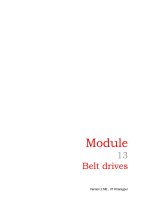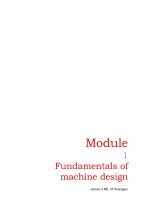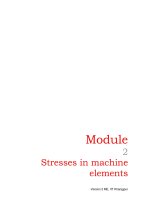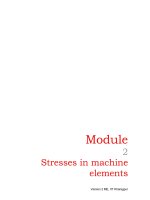Fundamentals of Machine Design P34
Bạn đang xem bản rút gọn của tài liệu. Xem và tải ngay bản đầy đủ của tài liệu tại đây (80.12 KB, 8 trang )
Module
11
Design of Joints with
Special Loading
Version 2 ME , IIT Kharagpur
Lesson
3
Design of Joints with
Variable Loading
Version 2 ME , IIT Kharagpur
Instructional Objectives :
After reading this lesson the students should learn:
• Design of a bolted joint with fluctuating loading
• Design of welded joints with variable loading
1. Variable loading in mechanical joints:
Machine parts are often subjected to variable loading. In many cases
pulsating or intermittent loads are applied from outside, for example, in
punching press forces of very large magnitude is applied for a short while
(impulsive force), in crank shafts variable loads act due to nature of force
arising from combustion cycle in cylinders. Often dynamic forces appear in
the moving parts, e.g., inertia forces in machines and mechanisms, forces
due to unbalance of the rotating components etc. Since these forces are to be
withstood by the joints, care should be taken while designing a joint capable
of resisting adequate load of variable magnitude. Design of two important
mechanical joints is discussed below, namely, bolted and welded joints.
2. Bolted joints with variable loading:
Consider design of bolts to fasten a flat cover to a cylinder as shown in figure
11.3.1. In order to ensure leak proofness necessary pretension (usually 2840
d , in Newton while the nominal bolt diameter d is measured in millimeter) is
applied. Depending upon operating condition the pressure inside the closed
cylinder is likely to vary in somewhat periodic manner. Let the minimum and
maximum value of the pressure be
min
p and
max
p , respectively.
Version 2 ME , IIT Kharagpur
Bolt
location
P
Figure 11.3.1: Bolted cover plate
The pressure causes external force of magnitude
c
pA
F
n
=
, where
n= number of equally spaced bolts on the bolt circle
= area of cross section of the cylinder
c
A
p = fluid pressure inside the cylinder.
It is known that only a fraction of external load is responsible for tensile stress
within bolts, that is
bi
FFCF= +
where = initial tension in the bolt
i
F
C = factor that depends on the nature of joints. Some
representative values of C’s are tabulated in Table 1 below.
Table 1. Values of C for various types of joints
Type of joint Value of C
Metal to metal joint with through bolt 0.00 – 0.10
Soft copper gasket with long bolts 0.5 – 0.7
Hard copper gasket with long bolt 0.25 – 0.5
Soft packing with through bolt 0.75 – 1.00
Soft packing with stud 1.0
Version 2 ME , IIT Kharagpur
Due to fluctuating external force the tensile load within each bolt takes
minimum and maximum value of
,min minbi
FFCF=+
and
,max maxbi
FFCF= +
respectively. The average and the fluctuating component of the normal stress
are given by
max min max min
max min max min
22
22
i
m
bb
amp
b
FFF
C
AA
FF
C
A
σσ
σ
σσ
σ
++
==+
−−
==
respectively, where is the root area of each bolt. The advantage of initial
pretension is at once visible from the above expressions. The ratio
b
A
amp
m
σ
σ
gets
drastically reduced, The safe size of the bolt can be calculated now from well-
known Soderberg equation given below
1
famp
av
YE
k
SN
σ
σ
σ
+ =
where
Y
σ
= Yield stress of the bolt material,
= Corrected endurance limit taking load-, size-, surface finish-
factors
E
S
N = Factor of safety
f
k
= fatigue stress concentration factor.
Alternatively, Goodman’s equation or Gerber’s line may be used to calculate
the root area and hence the size of the bolts. The fatigue stress concentration
factor plays an important role in the design. These are found by doing
extensive experimentation. A few figures are shown in Table 2.
Version 2 ME , IIT Kharagpur









